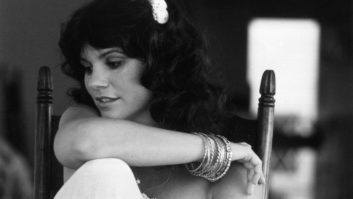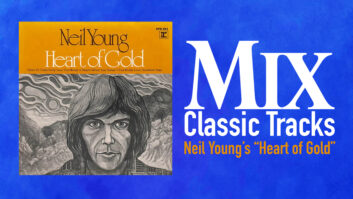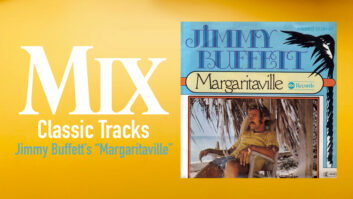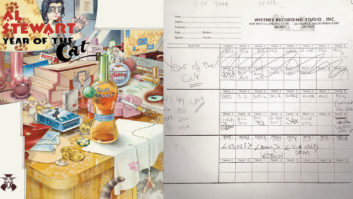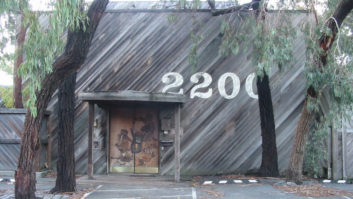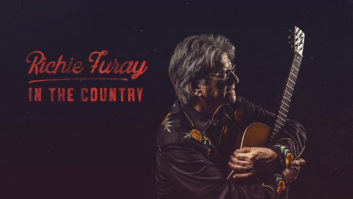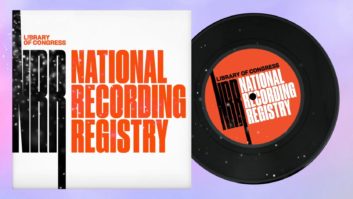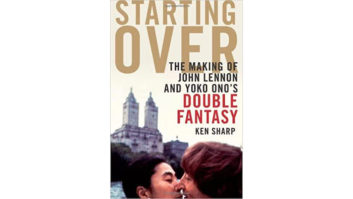GOTTA SING!It is the hottest day of the summer so far in Nashville – 102 degrees – and Linda Ronstadt is in town working on her Christmas album (A Merry Little Christmas). But contrasts have characterized her entire career. Though she was a major influence in defining country-rock music, putting songs by Hank Williams and Holland/Dozier/Holland on the same recordings was the norm for her. This day, she is working with her longtime engineer/producer and Nashville resident George Massenburg and John Boylan, a producer who worked with Ronstadt at the very beginning of her solo career and again in its more recent and mature iterations.
Ronstadt’s never been one to sit still for long, stylistically. From her first chart success with her L.A. bar band the Stone Poneys, through her Peter Asher-produced mega-hits of the ’70s, which found her interpreting country, Motown, rock `n’ roll and the creme de la creme of SoCal (and other) singer/songwriters, to her fascinating explorations of classic pop vocal music (the albums with the Nelson Riddle Orchestra), light opera (The Pirates of Penzance), opera (La Boheme), Mexican folk music (Canciones De Mi Padre and Mas Canciones), trio singing with Dolly Parton and Emmylou Harris, children’s music and more, Ronstadt has touched a lot of bases. What runs through it all is her passion for singing and intelligent arrangement and a certain integrity she brings to every project.
Ronstadt left her mark on more than the record business; her devotion to the craft of singing influenced many audio professionals. Massenburg, who first worked with her in 1974 recording “Keep Me From Blowing Away” at a studio in Silver Springs, Md., observes, “Working with Linda has been the most important artistic relationship of my life. This is the woman from whom I learned what singing is – the power and the charm and the importance of the story.”
Up close, Ronstadt is intensely knowledgeable about the mechanics of singing and the cultural contexts of every genre she passes through and is laissez-faire about the success part. For her, judgments are not made by RIAA-awarded Platinum trophies but by an internal meter she alone reads. “I know when I’ve done something well, and when I’ve done something not so well,” she states. Her knowledge of the motor effects of native language on vocalization and the history of Latin and classical music is extensive. A conversation with Ronstadt is like a journey planned by a mischievous travel agent – unscripted, landing in unexpected ports of call at unexpected moments. But it is invariably a fascinating itinerary.
What are your earliest studio memories? Was it with the Stone Poneys?
Earlier than that. There was Lee Furr, who was associated with George Massenburg in the early days in Baltimore. There was a studio called Copper State Recording Company in Tucson owned by Foster Cayce where Lee worked as an engineer. We recorded there with my brother Peter and my sister Suzy. We were a folk group called the New Union Ramblers. There was a lot of seminal stuff happening there, but I was very dedicated to traditional music – most of us in my family [were], because we did a lot of traditional Mexican music in the family. I never had a real fondness for mainstream music. Even when I was kid, I didn’t like “How Much Is That Doggie in the Window.” I knew there was something better. And I liked the Mexican music that I heard. It made you feel like you knew where you lived. That kind of regional music is almost gone now; radio has really destroyed it. But radio also gave me a taste for bluegrass music and a wish to emulate it. Because I heard it so early, I can sing around that kind of music, but I don’t have that kind of authenticity that Emmylou or Dolly has. They were raised in the South; I was raised in the Southwest.
You certainly sound comfortable in the country and bluegrass idioms.
I really have a whole theory about languages and what they develop in the musculature of the larynx, and the language that you grow up speaking determines what will be all the colorations of your voice. There’s something about Scottish Gaelic and Irish Gaelic and Welsh that puts you way up on the top of your voice that makes trills very accessible. Same way with the kind of singing that they do in New Orleans, which comes from French Baroque opera. Because the Creoles all sent their children to be educated in Europe, they came back speaking and singing French. In French Baroque opera, the men go right into the falsetto. The idea of belting the high notes was more from the Italian opera around the turn of the century. So the kind of music that Aaron Neville sings is not like the rest of R&B throughout the South; it is Catholic, it’s French Baroque, and when he goes up high he goes into falsetto and does the trills. In opera in the 18th century, you were expected to bring your own embellishments. You read the text, but you were also expected to embellish freely. So in a sense, opera was like jazz; it was improvisational. So when you hear someone who comes from the Protestant side of R&B, like Wilson Pickett, they were belters. And someone like Aaron sings like a choirboy. That’s the 18th-century singing technique. I sing from a Mexican point of view. Dolly sings from generations of people that spoke Scottish or Irish Gaelic. It was preserved there. The pronunciation of English is still affected by the history of that language.
Why did you and Emmy and Dolly work so well together vocally?
It was completely from sound. When Dolly and I and Emmy sang, it was a beautiful and different sound I’ve never heard before. I analyzed it years later. Dolly’s voice has a real horn-like quality on the top. My voice is thicker and bigger – it’s like lead on the bottom. That was the key to it – the three voices were so different.
On the Trio records, how did you record the vocals – ensemble or individually?
We did them as individual parts, because we didn’t have the luxury of spending a lot of time together on a tour bus, and we never performed together. So knowing how each other’s moves are going to go takes years. But we all sing totally differently with totally different instincts in terms of phrasing. With a woman’s voice, it’s whether you’re on the edge of falsetto or on the edge of chest. So Emmy will sing from the chest, but the falsetto keeps mixing in all the time. That’s what makes her have that crystalline quality in her voice – it sounds like cracked crystal sometimes. The crystal parts are incredibly clear. We’d work the parts out together. I did most of the harmony arranging, and Emmy helped a lot with the instrumental arranging. That way we could see exactly where each of us went into falsetto.
Were you involved in choosing microphones?
I know nothing about technical stuff. It mutates faster than a virus. That’s why I have someone like George [Massenburg]. If you don’t have the ability to think intuitively and musically, then you can get bogged down in that. There are people who are going to make music regardless of how technical they are. But there are a lot of people who get bogged down in it. I don’t care two beans about it. I know what the machines can do, I know what the different echo units sound like, I know what they can give me. But I don’t like to learn their names. It’s like alphabet soup with a handful of numbers thrown in. I always rename them, like “Fluffy” or “Spot.” I don’t have a computer, a TV, I don’t have a microwave, a dishwasher – anything that blinked in my house, I threw it out.
Where was Different Drum recorded?
At Capitol Studios [in L.A.]. I wanted to make a bluegrass record. I was attached to traditional music, and here’s this orchestrated thing, and I didn’t like it…
So you were dragged kicking and screaming into the music business?
How kicking and screaming can you be when you don’t have any money, and you don’t have a [record] deal? So you do what you’re told. I was very surprised when it was a hit. I was staggered, because I didn’t think it was very good. I think we did maybe three takes of it, and maybe the record was take two. But at least we had ambient rooms. See, as much as I’m a Luddite, I’m a haranguer for room ambience. I love room ambience. And the worst thing that happened to us in the ’70s was that everybody went into these little tiny rooms that were so ungratifying. The carpeting alone was enough to kill you if you were allergic to it. I left a studio in L.A., because they put in carpeting, Val Garay’s Studio.
So how did you reconcile your musical instincts with the pop music business?
I remember The Byrds were happening and doing folk-rock, and I thought, there you go. So I went to the Troubador. I grew up singing Mexican music, and that’s based on indigenous Mexican rhythms. Mexican music also has an overlay of West African music, based on huapango drums, and it’s kind of like a 6/8 [time signature], but it really is a very syncopated 6/8. And that’s how I attack vocals. Rock `n’ roll comes from black music, and I came from Mexican music.
But when you sang country, like “I Can’t Help It if I’m Still in Love With You,” it sounded like an homage. But when you sang R&B, like “Heat Wave,” it didn’t sound like Motown at all.
I didn’t know how to phrase it. The only reason I sang “Heat Wave” was because we had a club act, and when you have a club band you have to have fast stuff. I was a ballad singer. I would have been happy for the rest of my life singing “Heart Like a Wheel.” But in the clubs you needed stuff like “Heat Wave” and “When Will I Be Loved.” Peter Asher did a great job with the track on “You’re No Good,” but the vocal’s terrible. I just didn’t know how to sing it. I think the track really helped to sell it.
Speaking of Peter Asher, what was it like to find producers that you could work with?
The reason I started to work with Peter Asher, when I showed him “Heart Like a Wheel,” which I’d taken to a couple of other producers who thought it was too corny, it won’t be a hit, he thought it was charming, and he loved it. And he understood why I wanted to record it and understood why I wanted a cello on it. He understood the McGarrigle Sisters [writers of the song] – if people don’t get the McGarrigle Sisters, I don’t get them. I’ve had people say they sound like they’ve been eating goat meat, but they have an eccentric, beautiful sound.
As soon as I started working with John Boylan, I started co-producing myself. I was always a part of my productions. But I always needed a producer who would carry out my whims. Producers work in a lot of different ways. They either work autonomously or work as a collaborator. When I worked with John and Peter, they did that. They also brought some balance. I’m not very organized. Sometimes I asked for things that weren’t realistic, or too expensive, or that were so flat-out, non-commercial that had we done a record with that we wouldn’t have made another one. Left to my own devices, I would have just become an opera singer.
What was the studio environment in the ’70s with Peter Asher?
A lot of camaraderie. We rehearsed with the same band that we recorded with and went on the road with. It was sort of a seamless unit. We were also one of the first artists to give points to the band. I think Jackson [Browne] and I were the only artists besides Elvis Presley that were giving points to the band. What that did is it made it more of a collaboration. One of the skills of a good producer or the savvy of an artist is figuring out how to cast the music with the players you hire. And once you get those players, you want to hang on to them. Our stage versions sounded exactly like the records.
You were recording much of the material live in the studio in those days, weren’t you?
I didn’t learn how to overdub vocals until I met George Massenburg. George Massenburg taught me and Peter Asher how to overdub vocals. He’s a genius at it. And Peter has learned it seamlessly. One of the things that I like about Peter is that he’s not afraid to learn something. He’s not a know-it-all.
By the time Heart Like a Wheel came out, the studio band had really coalesced. How did the band evolve in the studio from making country-rock records to rock records?
All I did was try to do things I admired. Of course, they didn’t come out sounding anything like that, but that was me. People don’t realize how much George Jones copied Hank Williams, or how much Ray Charles copied Nat Cole when they were starting out. I tried to copy anything I heard – Judy Collins or Bill Monroe. I didn’t care much for female country singers ’til Dolly Parton and Emmy, ’cause they just sound so twangy. So I always tried to sing like the men. And I wound up sounding twangy anyway. [Laughs.]
Those are real guitar-oriented records…
And I hate guitars! Took me years and years to deal with that.
But those records were characterized by the triple guitar harmony parts…
Those were all my ideas. The arrangement for “That’ll Be the Day” was all mine from beginning to end, including the rhythm guitar parts.
The only guitar I like is Ry Cooder. And David Lindley, I would think.
I’d rather hear him play some other instrument. I just don’t like guitars. [Laughs.]
You were working in the studio with some very brilliant and assertive talents, like Asher, Andrew Gold, J.D. Souther. Was there a hierarchy in the studio for those records?
We needed someone to keep order, and Peter was very good at that. The band would put ideas on the table, and we’d try them. I usually came in with the songs and the direction I wanted to go in. I also came up with the arrangement ideas. Like “When Will I Be Loved” – I had ideas for the rhythm parts and the solo. I took ideas from a lot of places, and we’d try things. If I brought in an R&B song, the more country I’d try to do it; put a pedal steel guitar and dobro and bluegrass harmonies. And if I brought in a country song, the more rock `n’ roll we’d try to do it.
How would you characterize your working relationship with Peter Asher?
Peter was very good, because he was very organized. He did what he could to try to help me fulfill what I was trying to do. At the same time, he had his eye on the charts. And that’s a tight line to walk. I don’t walk that line well. And often I think we fell more onto the commercial side of the line, and I didn’t like them very much. It wasn’t his fault. It was my fault. Maybe I should have been more…There’s just so much pressure on you to succeed, and making a successful record means you get to do another record. So there were certain things that I protected that I had to have a certain way, and the other things I allowed them to be as they needed commercially. There’s nothing wrong with being manipulated, as long as you know who you are and everyone’s in agreement about it. And I think that’s what Peter does well.
George Massenburg is a recurring character in your career.
Get Closer [1982] was the first record I made all the way through with George. I’d been trying to work with George for years. I had met him in the early ’70s. He had cut one of the tracks, “Keep Me From Blowing Away,” on Heart Like a Wheel. I got sick, and I stayed in Washington, and we decided to go into a studio there. John Starling introduced me to George, and he was wonderful in the studio. He moved out to L.A., and I told Peter about him and wanted to work with him, but when you’ve been with a person for a long time, like we were with [engineer] Val Garay, you don’t want to change. So it took awhile.
Did you have a microphone that you especially liked to use for your vocals?
There was one that we loved that the capsule was damaged in some way. We used it on everything, but it broke while we were doing one of the Nelson Riddle records. It broke in the middle of the session. The capsule just screamed and melted.
[Massenburg knew the microphone immediately – a Neumann U67, which he had purchased years before from Deane Jensen. “It was in the middle of a Nelson Riddle session,” he recalls. “It made a squeal, a pop and it was dead. The capsule was very beaten up, and it touched the backplate and shorted out. It was one of those 0.7-micron capsules that cost as much as a car.” And both confirm that the microphone itself is bequeathed to Ronstadt in Massenburg’s will.]
What studios were you fond of in L.A.?
I didn’t care particularly, as long as it had an ambient room. We worked out of Sunset Sound for a long time. I didn’t record at Gold Star, but I remember walking into a session that Phil Spector was producing, and there were three rhythm guitars stacked up and three different-sized tambourines and maracas and castanets, all stacked up on the backbeat. That’s what gave it that wall of sound. They were orchestrated records; they put strings on them, but that wasn’t part of the effect – it was really how he stacked the backbeat. And for my whole life, I wanted to do that.
You had big drum sounds on your records.
All big drums do is knock the vocal out. Those records, the way they were stacked, there was room to put the vocals in. The stuff was stacked above and below, and Phil Spector knew how to record women’s voices. The problem with rock `n’ roll, if you take a Neil Young song that was written in the right key for his voice, when you change the key you lose the voicings. But he sang in a falsetto, so it was easy for me to cover, because there was room for the vocal to fit. That’s why for me to sing a song like “Back in the U.S.A.” is just a waste of my time. As interesting and innovative as that material and Chuck Berry were, it was written by a guitar player to give him something to do while he was waiting to take his guitar solo and do a duckwalk across the stage. There’s nothing for a singer to do. Ditto for Buddy Holly.
So why did you do those songs?
Because we didn’t have enough songs. I’d come into the studio with five ballads, like “Heart Like a Wheel.” And we needed uptempo material to fill out the records.
And how did you feel about the fact that those were the ones that became such big hits?
I was so sad that those were hits. I always hoped that something like “Heart Like a Wheel” would be the hit. Then I got stuck singing them year after year, until I decided to stop singing them.
Was your dissatisfaction with that situation part of what drew you to such a radical shift in focus toward the big band material?
That came about because I was sick of what I was singing, and I knew there was better material. All of pop music written in the first 50 years of this century was better than all of the songs written in the second 50 years. I wanted those songs. I don’t like to take material out of its period, which I had done with country-rock, but all of a sudden I wanted to seat it firmly in its period.
See, it’s not fair to those songs [to sing them] without a context. And I’d always been the queen of eclectic mania, with R&B and country and Motown on the same record. But the standards were meant to be supported a certain way. If you put an orchestra on three chords, it’s just a waste of the orchestra, because there’s just not enough musical complexity for the orchestra to speak. But things that were written by Gershwin had a lot for the orchestra to get its teeth in. All of those passing tones and incredibly complex chords that came out of the New Modernism of the turn of the 20th century. Charles Ives was the first one, and Gershwin took it up with a vengeance and made it accessible. Why Nelson was so important was that he took jazz and combined it with the orchestra and compromised neither genre. Both of them flourished under his approach.
With Winter Light, We Ran and your records of the 1990s, you finally chose to credit yourself as producer. Around the same time, you also produced records for other artists for the first time, including David Lindley’s Very Greasy (1988, co-produced with Edd Kolakowski), Jimmy Webb’s Suspending Disbelief (1993, with George Massenburg) and Aaron Neville’s Warm Your Heart (1991, also with Massenburg). What led you into production?
The reason I produced Aaron and David’s records, they both had played as sidemen on my records, they saw how I worked and saw how much input I had on the records, and they asked me to produce them. And the reason I really wanted to do David’s record was I had heard him live and wanted to make a record that sounded like it was onstage. For me, recording is always working from memory. I have to have heard something, and it plays in my head like a jukebox. And because I’m a technophobe, you have to have a good working relationship with a good engineer who understands how you speak in metaphor, and you have to have enough of a common bibliography of records. So I can turn to George and say, “Remember how the guitars sounded on that record?”
With Jimmy’s record, we stretched the budget so we could get the orchestration on it that we wanted. I think he, along with Brian Wilson, are the songwriters in the second half of the century that really can write for singers. And there’s no one else but Jimmy who can write for the orchestra, as well. His songs are so range-y that few people could actually sing them. Whereas Gershwin could write for the sweet spot of the singer, Jimmy will send his own vocals off the edge – he takes incredible chances.
Maybe a lot of your pop career in the 1970s was, in a sense, building up a kind of capital to allow you to do what you wanted later.
Yeah! And I did! [Laughs.] [The record label] said, “We don’t think you should work with Nelson Riddle – it’s going to be the end of your career.” And I just looked at them like they had four heads. I thought, this isn’t a joke, or a choice. When I open my mouth, that’s what’s going to come out. It was the same way with Mexican music. It wasn’t a choice. I opened my mouth, and everything came out in Spanish. It had just been waiting in line, backed up like cattle in the chute in my brain, all waiting to come out.
Has George Massenburg been your main technical translator?
There’s no one like George. One time I had Russ Kunkel playing on “Don’t Talk” [from Winter Light]. I told Russ I wanted a cymbal swell. I said I wanted it to sound like a bubble coming up from a lava lamp, and he got it right away. I relate sounds to real things. When I was a kid growing up, all the B-29 [bombers] came back from the war to Tucson, where the aircraft graveyard is. Every B-29 that went to the war flew over my house on its way home. And the sound of it is like the cellos and double basses that I’ve put on my arrangements. It’s a low grind, the way those engines would [resonate] with each other. It’s on “After the Goldrush” we did on Trio. They’re stacked under the vocal, and it’s the same way the engines would tune against each other. And on Winter Light, I tried to make everything understated, like it was just a halo or a shadow of what the parts were.
Very different from the big hits days when everything was loud and brash.
That was the style in those days. And who’s to say what’s better? I don’t like any records. I don’t ever listen to records at home. I don’t like recorded sound, because I’m used to hearing it live. I hate CDs, because, more than anything else, they destroyed my interest and my ability to enjoy recorded music. Also, CDs are small. You needed a space in your home to play vinyl – the records were big and the equipment you played was big. You didn’t just bring it up to the bathroom. I don’t like to listen to music as background. I like it live, but I won’t go to an arena. I don’t like it in a huge hall. And I prefer it acoustic. Once it goes through electronics, it’s never going to be the same. Medieval churches – those places were sound machines. They were wonder machines. The architecture stimulates different hemispheres in the brain. So who wants to go into the Staples Center [in L.A.] and try to play music? It’s a dramatically hideous place from the outside and the inside. When things shifted from the Troubador era to the arena era, people stopped going to see each other play. When I would see Joni Mitchell at the Troubador, I would stay for every song and hear it all. Same with Jackson and Neil Young. You just don’t do that with arenas. You can’t hear the nuance in the music. It’s changed the way that we play music. Then television finished music off. It was the deathblow.
It used to be that people would go to hear gifted musicians who were in their area. Recordings tend to invalidate local productions. And the recording industry’s most damaging aspect has been that people don’t do their own singing anymore. We delegate singing to professionals. We put it on a disc. In the 18th century, there were volumes of music that were written for various stages of intimacy. It was a way to identify and process your feelings. You could sing out your broken heart all alone or use it to express your feelings to another person. We’ve taken away from people the ability to do it themselves. I think everyone should sing, and everyone should dance.
